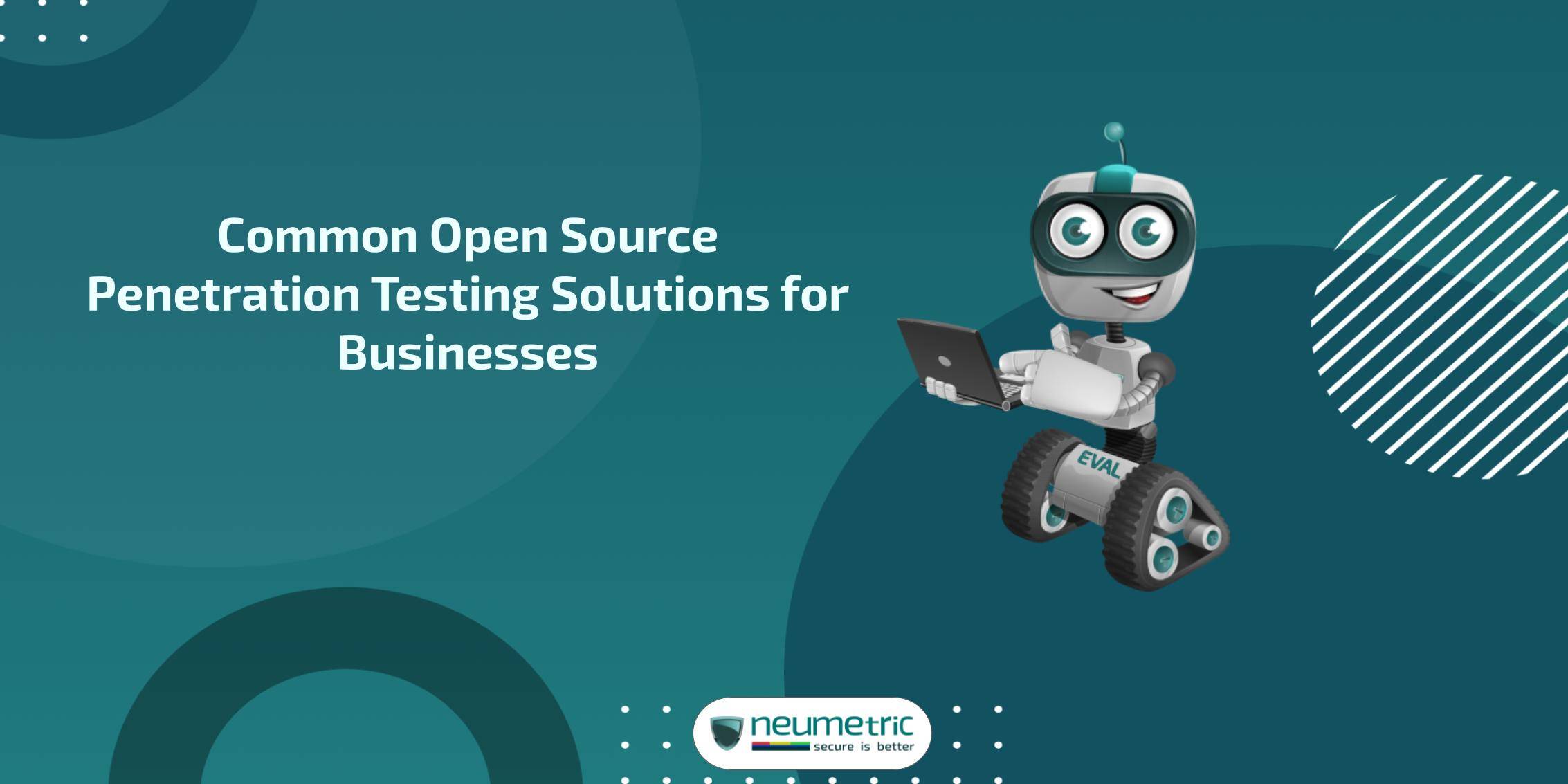Table of Contents
ToggleCommon Open-Source Penetration Testing Solutions for Businesses
Introduction
Penetration testing, often known as pen testing, is a method of proactive cyber security designed to mimic the attacks a company might face against its IT infrastructure, applications & networks. Authorized ethical hackers or penetration testers, perform these tests aiming to discover any system vulnerabilities that could be exploited by ill-intentioned actors. Penetration testing is of great importance to businesses as it helps measure their security resilience, spot any vulnerabilities & enable an effective risk management strategy.
By discovering potential breaches before they can be used by cybercriminals, companies can bolster their security measures, protect sensitive data & guard against the financial & reputational hits that often accompany security breaches.
Understanding Penetration Testing
Penetration testing involves simulating cyberattacks to identify vulnerabilities in an organization’s IT infrastructure, applications & networks. It aims to uncover weaknesses that could be exploited by malicious actors, such as hackers, to gain unauthorized access, steal data or disrupt operations. Penetration testing is typically conducted by trained ethical hackers using a variety of techniques & tools.
Types of Penetration Testing
Penetration testing can be classified into different types based on the level of information provided to the testers & the scope of the assessment:
- Black-box Testing: Testers have no prior knowledge of the target system & simulate an external attacker’s perspective.
- White-box Testing: Testers have full access to the target system’s internal workings, including source code & architecture.
- Gray-box Testing: Testers have partial knowledge of the target system, simulating an insider threat or a compromised user scenario.
Penetration testing offers several benefits to businesses, including:
- Identifying Vulnerabilities: Penetration tests help uncover security weaknesses & vulnerabilities that could be exploited by cybercriminals.
- Risk Mitigation: By identifying & addressing vulnerabilities proactively organizations can reduce the risk of security breaches & data loss.
- Compliance Requirements: Penetration testing is often a requirement for regulatory compliance in industries such as healthcare, finance & government.
- Enhancing Security Awareness: Penetration testing raises awareness among employees about cybersecurity risks & the importance of adhering to security policies & procedures.
Common Open-Source Penetration Testing Tools
Open-source penetration testing tools are freely available software applications that help ethical hackers assess the security of IT systems & networks. These tools offer a cost-effective solution for conducting comprehensive security assessments & identifying vulnerabilities.
Categories of Open-Source Tools
Open-source penetration testing tools can be categorized into several categories, including:
- Network Scanning: Tools used to scan & map network infrastructures, identify active hosts & discover open ports & services.
- Vulnerability Assessment: Tools designed to detect & assess vulnerabilities in software, applications & systems.
- Exploitation: Tools used to exploit identified vulnerabilities & gain unauthorized access to target systems.
- Reporting & Documentation: Tools used to generate comprehensive reports & documentation of penetration test results.
Network Scanning Tools
Overview of Network Scanning
Network scanning tools are essential for gathering information about the target network, identifying active hosts & mapping out the network topology. These tools help penetration testers understand the scope of the assessment & identify potential entry points for exploitation.
Examples of Open-Source Network Scanning Tools
- Nmap: A versatile network scanning tool that supports host discovery, port scanning, version detection & OS fingerprinting.
- Zmap: A high-speed network scanner capable of scanning the entire IPv4 address space in a matter of minutes.
To use network scanning tools effectively, penetration testers should follow these best practices:
- Define the Scope: Clearly define the scope of the assessment, including the target IP range, ports to scan & scanning methodology.
- Minimize Impact: Configure scanning parameters to minimize network disruption & avoid triggering intrusion detection systems.
- Analyze Results: Analyze scan results carefully to identify active hosts, open ports & services running on the target network.
- Document Findings: Document findings in detail, including IP addresses, open ports, service versions & potential security vulnerabilities.
Vulnerability Assessment Tools
Vulnerability assessment tools help organizations identify & prioritize security vulnerabilities in their IT infrastructure, applications & networks. By conducting regular vulnerability scans, businesses can proactively identify & remediate weaknesses before they are exploited by cybercriminals.
- OpenVAS: A comprehensive vulnerability scanner that detects security vulnerabilities, misconfigurations & compliance issues in networks & web applications.
- Nessus: A widely-used vulnerability assessment tool that helps organizations identify & remediate security vulnerabilities across their IT infrastructure.
When conducting vulnerability scans with open-source tools, penetration testers should follow these steps:
- Schedule Scans: Schedule regular vulnerability scans to assess the security posture of the organization’s IT infrastructure.
- Configure Scan Parameters: Configure scan parameters, including target IP ranges, scan intensity & scan frequency, based on the organization’s requirements.
- Interpret Results: Analyze scan results to identify high-risk vulnerabilities, prioritize remediation efforts & develop mitigation strategies.
- Generate Reports: Generate comprehensive vulnerability assessment reports detailing identified vulnerabilities, severity levels & recommended remediation actions.
Exploitation Tools
Exploitation tools are used by penetration testers to exploit identified vulnerabilities & gain unauthorized access to target systems. These tools simulate real-world attack scenarios to assess the impact of security vulnerabilities & validate the effectiveness of mitigating controls.
- Metasploit Framework: A powerful exploitation framework that provides a wide range of exploits, payloads & post-exploitation modules for targeting various operating systems & applications.
- OWASP ZAP: An open-source web application security scanner that includes automated exploitation capabilities for identifying & exploiting vulnerabilities in web applications.
When using exploitation tools in penetration testing, it’s essential to consider the following risks & considerations:
- Legal & Ethical Considerations: Ensure that penetration testing activities are conducted within legal & ethical boundaries, with proper authorization & consent from the organization.
- Data Integrity: Exercise caution when exploiting vulnerabilities to avoid causing damage to target systems or compromising sensitive data.
- Impact Assessment: Assess the potential impact of exploitation on target systems, including the risk of system downtime, data loss & regulatory compliance violations.
Comprehensive reporting is essential in penetration testing to communicate findings, recommendations & remediation strategies effectively. Penetration test reports help organizations understand their security posture, prioritize remediation efforts & address identified vulnerabilities proactively.
Examples of Open-Source Reporting & Documentation Tools
- Dradis Framework: A collaborative reporting platform that helps penetration testers generate, organize & share penetration test reports with stakeholders.
- Faraday: An integrated platform for conducting & managing penetration tests, including reporting & documentation features for tracking findings & remediation progress.
When creating penetration test reports, penetration testers should include the following components:
- Executive Summary: A high-level overview of findings, risks & recommendations tailored for senior management & executives.
- Technical Details: Detailed technical findings, including identified vulnerabilities, exploitability & proof-of-concept demonstrations.
- Risk Assessment: An assessment of the severity & impact of identified vulnerabilities, prioritized based on risk level & potential business impact.
- Recommendations: Actionable recommendations for remediation, including mitigation strategies, patching guidance & security best practices.
Implement Open-Source Penetration Testing Solutions for Businesses
To implement open-source penetration testing solutions effectively organizations should develop a comprehensive penetration testing strategy that includes the following components:
- Scope Definition: Clearly define the scope of penetration testing activities, including target systems, applications & testing methodologies.
- Resource Allocation: Allocate resources, including personnel, tools & budget, to support penetration testing activities effectively.
- Frequency: Determine the frequency of penetration testing based on the organization’s risk tolerance, compliance requirements & industry best practices.
- Reporting & Remediation: Establish processes for generating comprehensive penetration test reports & addressing identified vulnerabilities through remediation & mitigation efforts.
Selecting the Right Combination of Tools for Your Business
When selecting open-source penetration testing tools for your business, consider the following factors:
- Compatibility: Ensure that selected tools are compatible with your organization’s existing IT infrastructure, applications & network environment.
- Feature Set: Evaluate the features & capabilities of each tool to ensure they meet your specific penetration testing requirements.
- Community Support: Consider the level of community support & active development for each tool, including user forums, documentation & online resources.
- Cost: Assess the total cost of ownership for each tool, including any associated licensing fees, support costs & training expenses.
Integrating penetration testing into the cybersecurity workflow requires collaboration & coordination across various teams & departments within the organization. Key steps include:
- Communication: Foster open communication & collaboration between the cybersecurity team, IT operations, development & business stakeholders to ensure alignment & support for penetration testing activities.
- Training & Education: Provide training & education to internal teams on penetration testing best practices, tools & techniques to enhance their cybersecurity awareness & readiness.
- Continuous Improvement: Establish processes for continuous improvement & learning, including post-mortem reviews, lessons learned sessions & knowledge sharing initiatives to enhance penetration testing capabilities over time.
Best Practices for Successful Penetration Testing
- Define Objectives: Before diving into the testing, it’s essential to sit down & figure out what exactly you’re trying to achieve. Think of it like planning a road trip – you need to know where you’re going & how you’re getting there.
- Obtain Authorization: Just like you wouldn’t barge into someone’s house uninvited, you need to get the green light from the higher-ups before starting any testing. It’s all about making sure everyone’s on board & knows what’s going on.
- Documentation: Keep track of everything like you’re writing a detective novel – document every step of the process, from the tools you’re using to the clues you find along the way. It’ll come in handy later for solving the mystery & making sure you’re following the rules.
- Stakeholder Engagement: Don’t be a lone wolf – get the whole team involved. From the tech wizards to the big bosses, everyone should be in the loop & ready to lend a hand when needed.
- Reporting: When the adventure is over, it’s time to tell the tale. Put together a report that’s easy to understand, like you’re explaining the plot of a movie to your friends. Highlight the important bits & spell out what needs to be done next.
- Feedback Loop: Just like any good detective, always be learning. After each case, gather the team for a debriefing session. Talk about what went well, what could’ve gone better & how you can crack the case even faster next time.
- Training & Education: Keep sharpening those detective skills. Stay up-to-date on the latest tricks of the trade & make sure everyone on the team knows how to spot a clue when they see one.
- Knowledge Sharing: Share the wealth of knowledge like you’re passing around a good book. Spread the word about what you’ve learned, whether it’s through training sessions or just chatting around the water cooler.
- Benchmarking: Compare notes with other detectives to see how you measure up. Are you cracking cases faster than the competition? Are there areas where you could use a little extra training? It’s all about finding ways to improve & stay ahead of the game.
Challenges & Considerations
- Scope Creep: Managing scope creep & maintaining focus on the objectives & goals of the penetration test can be challenging, especially in complex & dynamic environments.
- Resource Constraints: Limited resources, including budgetary constraints, time constraints & personnel shortages, can hinder the effectiveness & efficiency of penetration testing activities.
- Technical Complexity: Dealing with technical complexity, including diverse IT environments, evolving technologies & emerging threats, requires advanced skills, knowledge & expertise in penetration testing.
- Regulatory Compliance: Ensure compliance with relevant laws, regulations & industry standards governing penetration testing activities, including obtaining proper authorization & consent from the organization & stakeholders.
- Privacy Concerns: Protect the privacy & confidentiality of sensitive information, including personal data, intellectual property & proprietary information, throughout the penetration testing process.
Strategies for Overcoming Challenges & Mitigating Risks
- Stakeholder Engagement: Engage stakeholders throughout the penetration testing process, including IT teams, business units, legal & compliance, to ensure alignment & support for remediation efforts.
- Risk Management: Implement risk management practices to identify, assess, prioritize & mitigate risks associated with penetration testing activities, including developing mitigation strategies & contingency plans.
- Continuous Improvement: Foster a culture of continuous improvement & learning within the organization, including feedback loops, knowledge sharing & training & education initiatives to enhance penetration testing capabilities over time.
Conclusion
In this journal, we explored the fundamentals of penetration testing, including its definition, types, benefits, common open-source tools, implementation strategies, best practices, challenges & considerations. We discussed the importance of penetration testing for businesses to assess their security posture, identify vulnerabilities & mitigate potential risks effectively.
Open-source penetration testing tools offer a cost-effective solution for conducting comprehensive security assessments & identifying vulnerabilities in IT systems & networks. By leveraging open-source tools, businesses can enhance their cybersecurity posture, protect sensitive data & mitigate potential risks effectively.
As cyber threats continue to evolve & grow in sophistication, it’s essential for businesses to prioritize cybersecurity & invest in proactive measures such as penetration testing. By adopting a proactive approach to security & leveraging open-source tools, businesses can strengthen their defenses, protect against emerging threats & safeguard their valuable assets & reputation in today’s digital landscape.
Frequently Asked Questions [FAQ]
What is the difference between penetration testing & vulnerability scanning?
Penetration testing involves simulating real-world cyberattacks to identify vulnerabilities & exploit them to gain unauthorized access to systems or data. It assesses the effectiveness of security controls & measures the impact of potential security breaches. On the other hand, vulnerability scanning focuses on identifying & prioritizing vulnerabilities in systems, networks & applications. It typically involves automated tools that scan for known vulnerabilities & misconfigurations but do not attempt to exploit them.
Why is penetration testing important for businesses, especially those using open-source tools?
Penetration testing is essential for businesses to assess their security posture, identify vulnerabilities & mitigate potential risks effectively. By simulating real-world attack scenarios, businesses can uncover weaknesses in their IT infrastructure & applications before they are exploited by malicious actors. Leveraging open-source penetration testing tools offers several benefits, including cost-effectiveness, flexibility & community support. These tools provide businesses with access to a wide range of security assessment capabilities without the high costs associated with proprietary solutions.
What are some common challenges faced in penetration testing & how can businesses overcome them?
Common challenges in penetration testing include scope creep, resource constraints & technical complexity. Scope creep refers to the expansion of the testing scope beyond its original boundaries, making it difficult to manage & maintain focus on the objectives. Resource constraints, such as budgetary limitations & personnel shortages, can hinder the effectiveness & efficiency of penetration testing activities. Technical complexity, including diverse IT environments & evolving technologies, requires advanced skills & expertise in penetration testing. To overcome these challenges, businesses should engage stakeholders, implement risk management practices & foster a culture of continuous improvement & learning within the organization.





